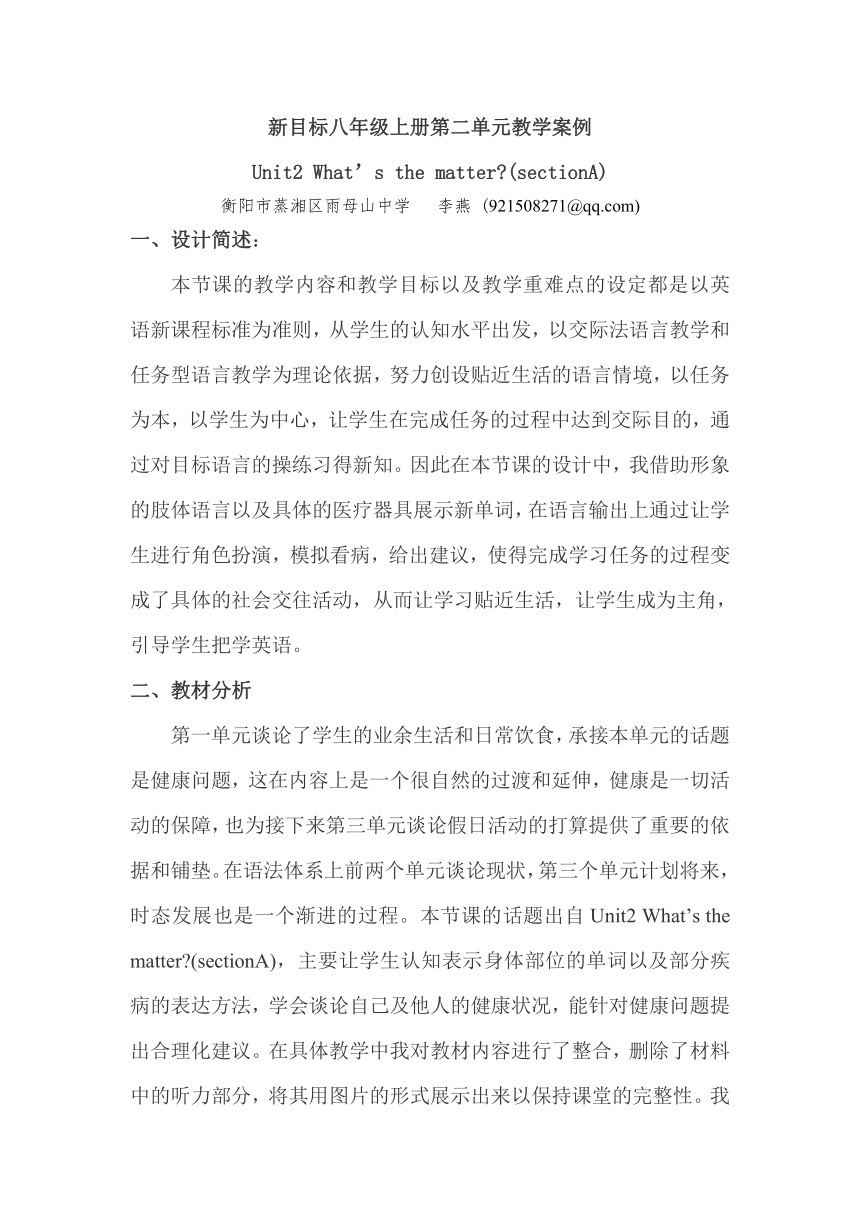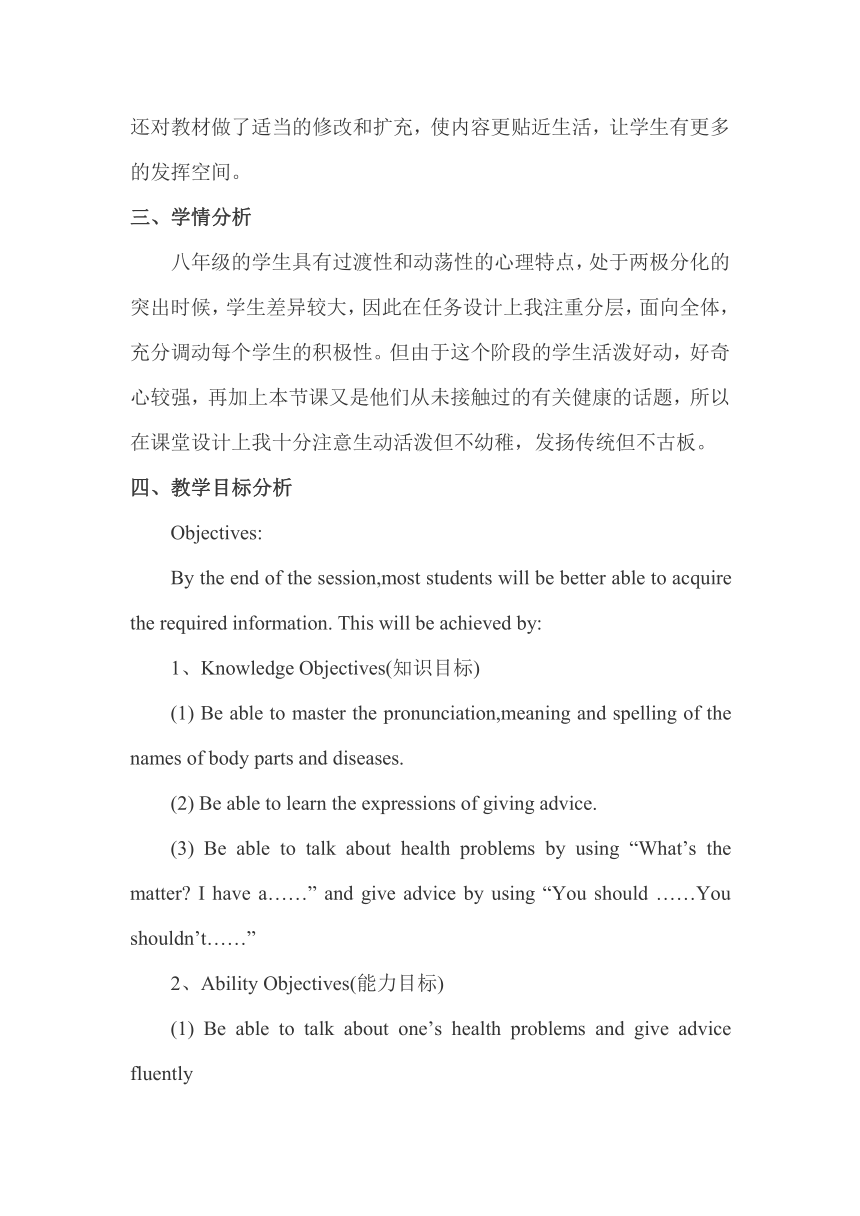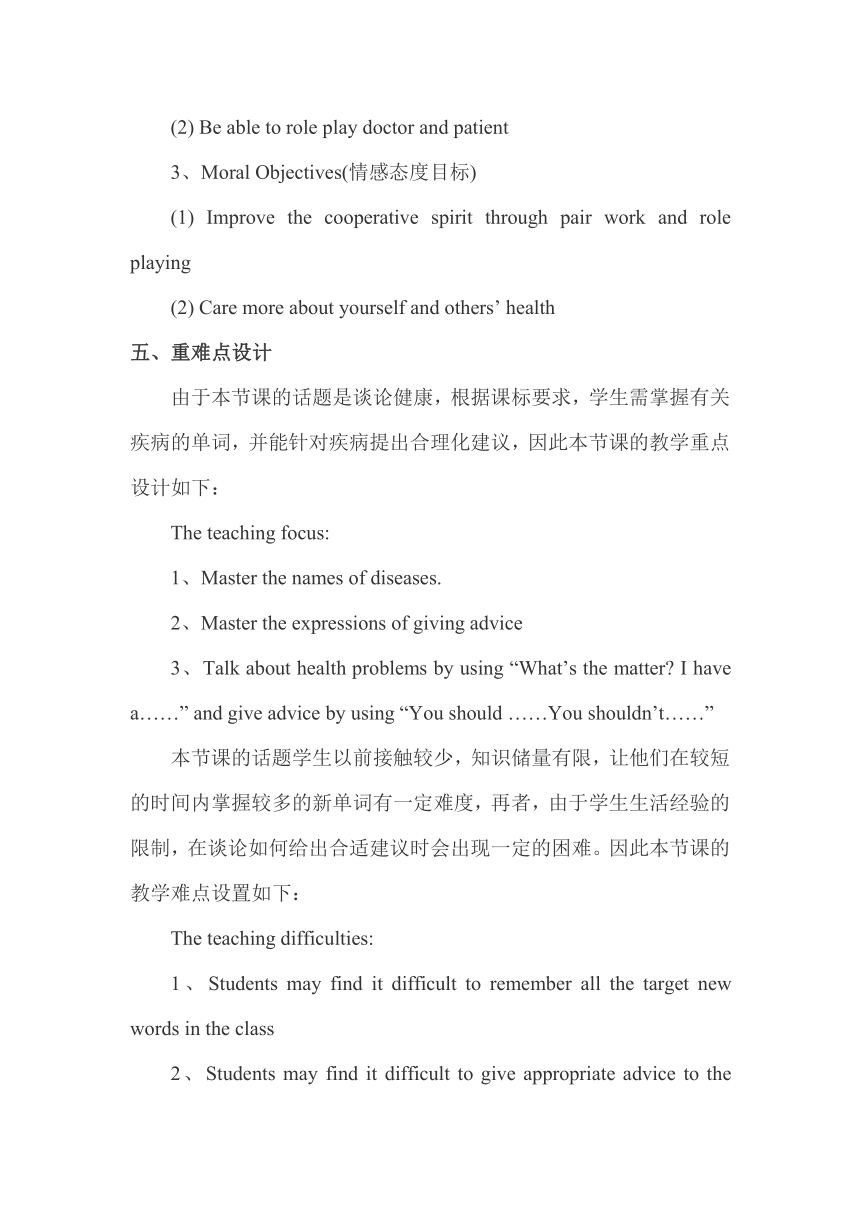Unit 2 What’s the matter?(Section A)教学案例
文档属性
| 名称 | Unit 2 What’s the matter?(Section A)教学案例 |  | |
| 格式 | zip | ||
| 文件大小 | 16.6KB | ||
| 资源类型 | 教案 | ||
| 版本资源 | 人教新目标(Go for it)版 | ||
| 科目 | 英语 | ||
| 更新时间 | 2012-03-26 19:50:04 | ||
图片预览





文档简介
新目标八年级上册第二单元教学案例
Unit2 What’s the matter (sectionA)
衡阳市蒸湘区雨母山中学 李燕 (921508271@)
一、设计简述:
本节课的教学内容和教学目标以及教学重难点的设定都是以英语新课程标准为准则,从学生的认知水平出发,以交际法语言教学和任务型语言教学为理论依据,努力创设贴近生活的语言情境,以任务为本,以学生为中心,让学生在完成任务的过程中达到交际目的,通过对目标语言的操练习得新知。因此在本节课的设计中,我借助形象的肢体语言以及具体的医疗器具展示新单词,在语言输出上通过让学生进行角色扮演,模拟看病,给出建议,使得完成学习任务的过程变成了具体的社会交往活动,从而让学习贴近生活,让学生成为主角,引导学生把学英语。
二、教材分析
第一单元谈论了学生的业余生活和日常饮食,承接本单元的话题是健康问题,这在内容上是一个很自然的过渡和延伸,健康是一切活动的保障,也为接下来第三单元谈论假日活动的打算提供了重要的依据和铺垫。在语法体系上前两个单元谈论现状,第三个单元计划将来,时态发展也是一个渐进的过程。本节课的话题出自Unit2 What’s the matter (sectionA),主要让学生认知表示身体部位的单词以及部分疾病的表达方法,学会谈论自己及他人的健康状况,能针对健康问题提出合理化建议。在具体教学中我对教材内容进行了整合,删除了材料中的听力部分,将其用图片的形式展示出来以保持课堂的完整性。我还对教材做了适当的修改和扩充,使内容更贴近生活,让学生有更多的发挥空间。
三、学情分析
八年级的学生具有过渡性和动荡性的心理特点,处于两极分化的突出时候,学生差异较大,因此在任务设计上我注重分层,面向全体,充分调动每个学生的积极性。但由于这个阶段的学生活泼好动,好奇心较强,再加上本节课又是他们从未接触过的有关健康的话题,所以在课堂设计上我十分注意生动活泼但不幼稚,发扬传统但不古板。
四、教学目标分析
Objectives:
By the end of the session,most students will be better able to acquire the required information. This will be achieved by:
1、Knowledge Objectives(知识目标)
(1) Be able to master the pronunciation,meaning and spelling of the names of body parts and diseases.
(2) Be able to learn the expressions of giving advice.
(3) Be able to talk about health problems by using “What’s the matter I have a……” and give advice by using “You should ……You shouldn’t……”
2、Ability Objectives(能力目标)
(1) Be able to talk about one’s health problems and give advice fluently
(2) Be able to role play doctor and patient
3、Moral Objectives(情感态度目标)
(1) Improve the cooperative spirit through pair work and role playing
(2) Care more about yourself and others’ health
五、重难点设计
由于本节课的话题是谈论健康,根据课标要求,学生需掌握有关疾病的单词,并能针对疾病提出合理化建议,因此本节课的教学重点设计如下:
The teaching focus:
1、Master the names of diseases.
2、Master the expressions of giving advice
3、Talk about health problems by using “What’s the matter I have a……” and give advice by using “You should ……You shouldn’t……”
本节课的话题学生以前接触较少,知识储量有限,让他们在较短的时间内掌握较多的新单词有一定难度,再者,由于学生生活经验的限制,在谈论如何给出合适建议时会出现一定的困难。因此本节课的教学难点设置如下:
The teaching difficulties:
1、Students may find it difficult to remember all the target new words in the class
2、Students may find it difficult to give appropriate advice to the certain disease because of their limited life experience.
六、教学方法和学习策略分析
(一)教学方法
(1)恰当运用多媒体辅助教学,提高课堂效率增加趣味性。
(2)以学生为中心,开展Role play, Guessing game, Pair work等英语教学活动。
(3)注重分层教学,尊重差异,让不同层次的学生都能参与,获得成就感。
(4)“任务型“活动策略,在做中学和练,任务明确,活动面广,使学生在交际中真实运用所学知识。
(二)学习策略
(1)Inferring vocabulary
(2)Role play
(3)Group and pair work语当成一种乐趣。
七、教学过程
(一)、Lead--in
Play a song for all the students (Ss) to sing along with---“If you are happy”.
While singing,touch the part that is mentioned in the songs .(clap your hand, stomp your feet , wink your eye ).
Then chang the song ,add up other parts-----If you are happy and you know it shake your head, open your mouth, lift up your leg, lift up your arm…… etc.
And the teacher(T) shows the pictures about body parts on the blackboard.
(设计说明:以学生熟悉的拍手歌开始本节课的教学,让学生在唱歌的同时完成对身体部位单词的认知,并通过对歌曲的改编联系更多的有关身体部位的单词。在开始新课前创设比较活泼轻松的学习氛围,激发学生的学习热情,为下面的教学做好铺垫。)
(二)、Presentation of words about body parts
T:Ok,class,we know the body parts just now. They are in altogether in one family, but I want to tell you that they can’t friendly.They will have a fight sometimes. If you can’t believe, let’s watch the programe-----Body fight.
After the programe,ask the Ss: Now,do you know ----Why do they fight What are they fight for
Ss:Who is important
T:Good! Do you think who is the most important And tell me the reason, Why
S1:Mouth, because I can’t eat to live without it.
T:What else can mouth do
S1:Drink, speak English, sing songs, talk with my friends……
S2:Ears, because I can’t grab my pen without them.
S3:Fingers, because I can’t grab my pen without them.
……
(as many as they can tell)
(设计说明:在完成对新单词的认知之后,我给学生展示了一个Body fight的视频节目,这个节目的题材很符合本节课,涉及了身体部位的学习。学生在完成老师的任务时大多采用了节目中的内容来对身体器官的作用进行阐述,加深了对新输入单词的理解巩固,为接下来疾病的学习打下基础。并且在这一环节中还训练了学生对输出信息的捕捉能力。)
(三)、Presentation of words about diseases
1、T:Everbody’s answers are very good. In fact, the body parts are in one family. They can’t fight, they can help us do many things, They are all important. So, we should take care of them. But the body parts has some problems sometimes.
The T use body language to guide the Ss to guess the illness: have a cold, have a fever
T: I am not feeling well now. I am ill. Do you know the illness What’s the matter with me
Ss:You have a fever. (show the illness---have a cold with the body language, too)
2、Then the T shows a bandage and tell the Ss there is something wrong in the place where the bandage lies.Then get Ss to guess the health problems. When the T does the actions,ask the Ss---What’s the matter (write it on the blackboard)
The T puts the bandage on the stomach, and asks: What’s the matter with me I’m not feeling well. I have a stomachache.
Next, the T puts the bandage on the other part of body and gets the Ss to guess the problems: have a toothache, have a headache, (show them on the blackboard)
T:Yes, look at the blackboard. Do you know how to use ache If my are aches, we can say I have an ……
Ss:I have an earache.
T:About the back
Ss:I have a backache.
T:Yes, and I can say I have a sore back, too.(show sore)
T:(the teacher coughs) What’s the matter with me my throat
Ss:I have a sore throat.
(设计说明:老师在课堂上展示医疗用具---绷带,唤起学生的好奇心,使其积极参与到教学活动中来。通过绷带所绑的不同位置和老师形象的肢体语言,自然的引出了有关疾病的单词,简单直观,易于学生接受。在此环节中,我还注重让学生大胆猜测,进行推理,在常态下自己总结运用一些简单的构词法,由已知引入未知,变教师单一讲授为师生互动交流,在交流中解决知识难点。)
(四)、Pair work
1、The T puts the bandage on the part of a student’s body and ask: What’s matter and guide him to use the pattern: I have a/an……
Then asks the Ss to work in pairs and talk about health problems by using the bandage and using the target languages: What’s the matter I have a/an……
Later act them out in the class.
2、After sever pairs, the T chooses one pair and ask other Ss:
T:What’s the matter with her
Ss:She has a headache.
Then the T ask some Ss to show the health problems with the body laguag, and ask other Ss to have conversations in pairs.
S1: What’s the matter with him/her
S2: He/She has a ……(自然引入第三人称单数的学习运用)
(五)、Presentation of expressions of given advice
T:Ok, we have so many problems in the practice just now. Don’ worry ,they are not true. But we are really ill one day. What should we do Now, I give you some pictures. I think they will help you find the answres.(将一些建议以图片的形式展示出来,降低信息差,使学生易于总结)
T:Suppose you are a doctor. If I have a cold/fever/toothache…….What shou I do What shouldn’t I do
S1:You should……
S2:You shouldn’t……(学生可随意发挥,必要时教师给予修正,最后将所有建议罗列出来,作为下面活动的提示语)
(设计说明:在这两个环节中,我一直以学生为中心,置学生于语言环境交际之中,调动学生的参与热情,将课堂教学成为一个师生共同学习创造的过程,由易到难,实现知识结构逐步上升。运用发散思维让学生提出建议,为下面的知识输出打下伏笔。)
(六)、Production
T: Do you want to be a doctor to help others Do you go to see a doctor when you aren’t healthy Today ,I give you a chance,now,suppose you are a doctor, and your group memmbers are your patients. They aren’t feeling well. Please make a dialogue to present the scene in the hospital. And you may use the expression given. Later let’s act out in the class.
(设计说明:这是一个综合运用环节,让学生在一个free—controlled的状态下用英语交流,用英语做事。通过医生和病人角色的扮演营造出真实的生活情境,为学生创设宽广的展示空间,不仅检测了所学知识,而且锻炼了用英语交际的能力。在体验中获得成功。)
(七)、Homework
T: Boys and Girls, many students have H1NI flu in DongYue Middle school. Suppose you are the mayor in Taian now, what should you do Please give some advice to the master of DongYue Middle school,and you will say …… to the students in that school.
(设计说明:这一环节是对本节课的升华和延伸,通过“假如我是市长”这一活动,让学生在巩固知识的过程中思考在防控甲流感中自己怎么做。它既来源于教材,又贴近生活,反应时政,达到了知识来源于生活,又回归生活,为生活服务的目的。)
八、教后反思
英语教学提倡体验、实践、参与、交流与合作的学习方式,要使学生尽可能多的从不同的渠道,以不同的方式接触和学习语言,亲身感受和直接体验语言,在互动中交流语言,在体验中生成知识,使语言的学习转变成一种创造和运用语言的体验过程,因此在教学中应遵循体验式教学模式,使得教师的输入和学生的输出科学的结合起来。
在本节课的教学中,我今量多设计贴近学生生活的语言情境,通过图片、实物等营造出医院的情景,让学生在接近真实中开展角色扮演活动,激发了他们的参与热情,整节课都洋溢着较高的学习热情。
在实际操作中,由于前面展示部分进行流畅,占据时间较多,最后的小组活动开展的不是很充分,不免遗憾。
Unit2 What’s the matter (sectionA)
衡阳市蒸湘区雨母山中学 李燕 (921508271@)
一、设计简述:
本节课的教学内容和教学目标以及教学重难点的设定都是以英语新课程标准为准则,从学生的认知水平出发,以交际法语言教学和任务型语言教学为理论依据,努力创设贴近生活的语言情境,以任务为本,以学生为中心,让学生在完成任务的过程中达到交际目的,通过对目标语言的操练习得新知。因此在本节课的设计中,我借助形象的肢体语言以及具体的医疗器具展示新单词,在语言输出上通过让学生进行角色扮演,模拟看病,给出建议,使得完成学习任务的过程变成了具体的社会交往活动,从而让学习贴近生活,让学生成为主角,引导学生把学英语。
二、教材分析
第一单元谈论了学生的业余生活和日常饮食,承接本单元的话题是健康问题,这在内容上是一个很自然的过渡和延伸,健康是一切活动的保障,也为接下来第三单元谈论假日活动的打算提供了重要的依据和铺垫。在语法体系上前两个单元谈论现状,第三个单元计划将来,时态发展也是一个渐进的过程。本节课的话题出自Unit2 What’s the matter (sectionA),主要让学生认知表示身体部位的单词以及部分疾病的表达方法,学会谈论自己及他人的健康状况,能针对健康问题提出合理化建议。在具体教学中我对教材内容进行了整合,删除了材料中的听力部分,将其用图片的形式展示出来以保持课堂的完整性。我还对教材做了适当的修改和扩充,使内容更贴近生活,让学生有更多的发挥空间。
三、学情分析
八年级的学生具有过渡性和动荡性的心理特点,处于两极分化的突出时候,学生差异较大,因此在任务设计上我注重分层,面向全体,充分调动每个学生的积极性。但由于这个阶段的学生活泼好动,好奇心较强,再加上本节课又是他们从未接触过的有关健康的话题,所以在课堂设计上我十分注意生动活泼但不幼稚,发扬传统但不古板。
四、教学目标分析
Objectives:
By the end of the session,most students will be better able to acquire the required information. This will be achieved by:
1、Knowledge Objectives(知识目标)
(1) Be able to master the pronunciation,meaning and spelling of the names of body parts and diseases.
(2) Be able to learn the expressions of giving advice.
(3) Be able to talk about health problems by using “What’s the matter I have a……” and give advice by using “You should ……You shouldn’t……”
2、Ability Objectives(能力目标)
(1) Be able to talk about one’s health problems and give advice fluently
(2) Be able to role play doctor and patient
3、Moral Objectives(情感态度目标)
(1) Improve the cooperative spirit through pair work and role playing
(2) Care more about yourself and others’ health
五、重难点设计
由于本节课的话题是谈论健康,根据课标要求,学生需掌握有关疾病的单词,并能针对疾病提出合理化建议,因此本节课的教学重点设计如下:
The teaching focus:
1、Master the names of diseases.
2、Master the expressions of giving advice
3、Talk about health problems by using “What’s the matter I have a……” and give advice by using “You should ……You shouldn’t……”
本节课的话题学生以前接触较少,知识储量有限,让他们在较短的时间内掌握较多的新单词有一定难度,再者,由于学生生活经验的限制,在谈论如何给出合适建议时会出现一定的困难。因此本节课的教学难点设置如下:
The teaching difficulties:
1、Students may find it difficult to remember all the target new words in the class
2、Students may find it difficult to give appropriate advice to the certain disease because of their limited life experience.
六、教学方法和学习策略分析
(一)教学方法
(1)恰当运用多媒体辅助教学,提高课堂效率增加趣味性。
(2)以学生为中心,开展Role play, Guessing game, Pair work等英语教学活动。
(3)注重分层教学,尊重差异,让不同层次的学生都能参与,获得成就感。
(4)“任务型“活动策略,在做中学和练,任务明确,活动面广,使学生在交际中真实运用所学知识。
(二)学习策略
(1)Inferring vocabulary
(2)Role play
(3)Group and pair work语当成一种乐趣。
七、教学过程
(一)、Lead--in
Play a song for all the students (Ss) to sing along with---“If you are happy”.
While singing,touch the part that is mentioned in the songs .(clap your hand, stomp your feet , wink your eye ).
Then chang the song ,add up other parts-----If you are happy and you know it shake your head, open your mouth, lift up your leg, lift up your arm…… etc.
And the teacher(T) shows the pictures about body parts on the blackboard.
(设计说明:以学生熟悉的拍手歌开始本节课的教学,让学生在唱歌的同时完成对身体部位单词的认知,并通过对歌曲的改编联系更多的有关身体部位的单词。在开始新课前创设比较活泼轻松的学习氛围,激发学生的学习热情,为下面的教学做好铺垫。)
(二)、Presentation of words about body parts
T:Ok,class,we know the body parts just now. They are in altogether in one family, but I want to tell you that they can’t friendly.They will have a fight sometimes. If you can’t believe, let’s watch the programe-----Body fight.
After the programe,ask the Ss: Now,do you know ----Why do they fight What are they fight for
Ss:Who is important
T:Good! Do you think who is the most important And tell me the reason, Why
S1:Mouth, because I can’t eat to live without it.
T:What else can mouth do
S1:Drink, speak English, sing songs, talk with my friends……
S2:Ears, because I can’t grab my pen without them.
S3:Fingers, because I can’t grab my pen without them.
……
(as many as they can tell)
(设计说明:在完成对新单词的认知之后,我给学生展示了一个Body fight的视频节目,这个节目的题材很符合本节课,涉及了身体部位的学习。学生在完成老师的任务时大多采用了节目中的内容来对身体器官的作用进行阐述,加深了对新输入单词的理解巩固,为接下来疾病的学习打下基础。并且在这一环节中还训练了学生对输出信息的捕捉能力。)
(三)、Presentation of words about diseases
1、T:Everbody’s answers are very good. In fact, the body parts are in one family. They can’t fight, they can help us do many things, They are all important. So, we should take care of them. But the body parts has some problems sometimes.
The T use body language to guide the Ss to guess the illness: have a cold, have a fever
T: I am not feeling well now. I am ill. Do you know the illness What’s the matter with me
Ss:You have a fever. (show the illness---have a cold with the body language, too)
2、Then the T shows a bandage and tell the Ss there is something wrong in the place where the bandage lies.Then get Ss to guess the health problems. When the T does the actions,ask the Ss---What’s the matter (write it on the blackboard)
The T puts the bandage on the stomach, and asks: What’s the matter with me I’m not feeling well. I have a stomachache.
Next, the T puts the bandage on the other part of body and gets the Ss to guess the problems: have a toothache, have a headache, (show them on the blackboard)
T:Yes, look at the blackboard. Do you know how to use ache If my are aches, we can say I have an ……
Ss:I have an earache.
T:About the back
Ss:I have a backache.
T:Yes, and I can say I have a sore back, too.(show sore)
T:(the teacher coughs) What’s the matter with me my throat
Ss:I have a sore throat.
(设计说明:老师在课堂上展示医疗用具---绷带,唤起学生的好奇心,使其积极参与到教学活动中来。通过绷带所绑的不同位置和老师形象的肢体语言,自然的引出了有关疾病的单词,简单直观,易于学生接受。在此环节中,我还注重让学生大胆猜测,进行推理,在常态下自己总结运用一些简单的构词法,由已知引入未知,变教师单一讲授为师生互动交流,在交流中解决知识难点。)
(四)、Pair work
1、The T puts the bandage on the part of a student’s body and ask: What’s matter and guide him to use the pattern: I have a/an……
Then asks the Ss to work in pairs and talk about health problems by using the bandage and using the target languages: What’s the matter I have a/an……
Later act them out in the class.
2、After sever pairs, the T chooses one pair and ask other Ss:
T:What’s the matter with her
Ss:She has a headache.
Then the T ask some Ss to show the health problems with the body laguag, and ask other Ss to have conversations in pairs.
S1: What’s the matter with him/her
S2: He/She has a ……(自然引入第三人称单数的学习运用)
(五)、Presentation of expressions of given advice
T:Ok, we have so many problems in the practice just now. Don’ worry ,they are not true. But we are really ill one day. What should we do Now, I give you some pictures. I think they will help you find the answres.(将一些建议以图片的形式展示出来,降低信息差,使学生易于总结)
T:Suppose you are a doctor. If I have a cold/fever/toothache…….What shou I do What shouldn’t I do
S1:You should……
S2:You shouldn’t……(学生可随意发挥,必要时教师给予修正,最后将所有建议罗列出来,作为下面活动的提示语)
(设计说明:在这两个环节中,我一直以学生为中心,置学生于语言环境交际之中,调动学生的参与热情,将课堂教学成为一个师生共同学习创造的过程,由易到难,实现知识结构逐步上升。运用发散思维让学生提出建议,为下面的知识输出打下伏笔。)
(六)、Production
T: Do you want to be a doctor to help others Do you go to see a doctor when you aren’t healthy Today ,I give you a chance,now,suppose you are a doctor, and your group memmbers are your patients. They aren’t feeling well. Please make a dialogue to present the scene in the hospital. And you may use the expression given. Later let’s act out in the class.
(设计说明:这是一个综合运用环节,让学生在一个free—controlled的状态下用英语交流,用英语做事。通过医生和病人角色的扮演营造出真实的生活情境,为学生创设宽广的展示空间,不仅检测了所学知识,而且锻炼了用英语交际的能力。在体验中获得成功。)
(七)、Homework
T: Boys and Girls, many students have H1NI flu in DongYue Middle school. Suppose you are the mayor in Taian now, what should you do Please give some advice to the master of DongYue Middle school,and you will say …… to the students in that school.
(设计说明:这一环节是对本节课的升华和延伸,通过“假如我是市长”这一活动,让学生在巩固知识的过程中思考在防控甲流感中自己怎么做。它既来源于教材,又贴近生活,反应时政,达到了知识来源于生活,又回归生活,为生活服务的目的。)
八、教后反思
英语教学提倡体验、实践、参与、交流与合作的学习方式,要使学生尽可能多的从不同的渠道,以不同的方式接触和学习语言,亲身感受和直接体验语言,在互动中交流语言,在体验中生成知识,使语言的学习转变成一种创造和运用语言的体验过程,因此在教学中应遵循体验式教学模式,使得教师的输入和学生的输出科学的结合起来。
在本节课的教学中,我今量多设计贴近学生生活的语言情境,通过图片、实物等营造出医院的情景,让学生在接近真实中开展角色扮演活动,激发了他们的参与热情,整节课都洋溢着较高的学习热情。
在实际操作中,由于前面展示部分进行流畅,占据时间较多,最后的小组活动开展的不是很充分,不免遗憾。
同课章节目录
- Unit 1 What's the matter?
- Section A
- Section B
- Unit 2 I'll help to clean up the city parks.
- Section A
- Section B
- Unit 3 Could you please clean your room?
- Section A
- Section B
- Unit 4 Why don't you talk to your parents?
- Section A
- Section B
- Unit 5 What were you doing when the rainstorm came
- Section A
- Section B
- Review of Units 1-5
- Unit 6 An old man tried to move the mountains.
- Section A
- Section B
- Unit 7 What's the highest mountain in the world?
- Section A
- Section B
- Unit 8 Have you read Treasure Island yet?
- Section A
- Section B
- Unit 9 Have you ever been to a museum?
- Section A
- Section B
- Unit 10 I've had this bike for three years.
- Section A
- Section B
